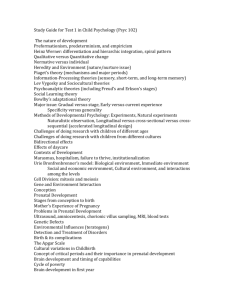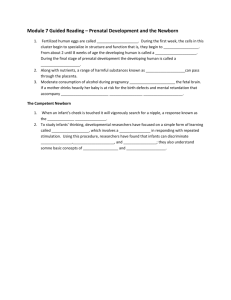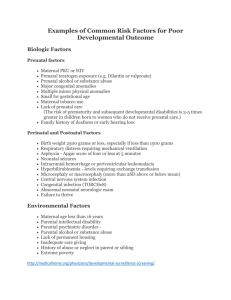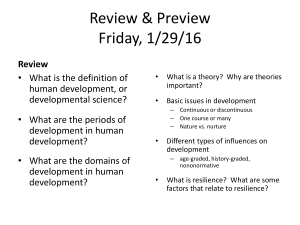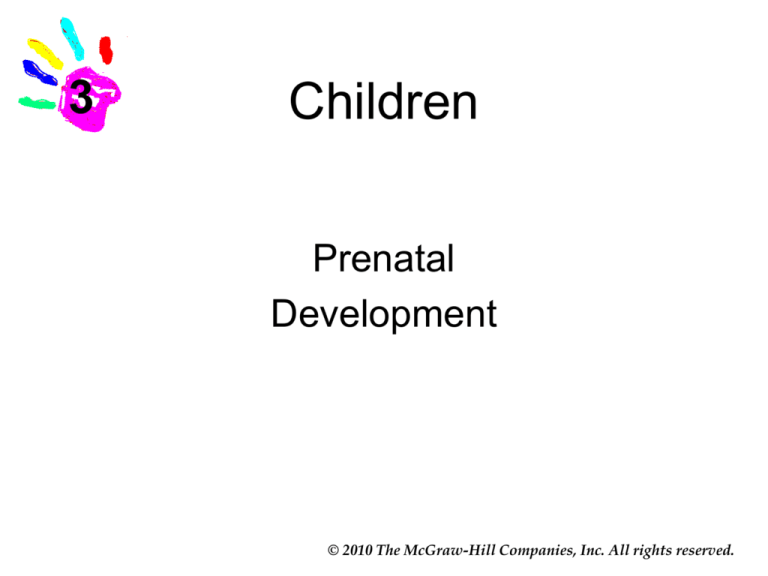
3
Children
Prenatal
Development
© 2010 The McGraw-Hill Companies, Inc. All rights reserved.
The Course of Prenatal Development
The Germinal Period
• First two weeks after conception
– Creation of zygote
– Blastocyst
• inner layer of cells
• develops into embryo
– Trophoblast
• outer layer of cells that develops during
germinal period, nourishes embryo
© 2010 The McGraw-Hill Companies, Inc. All rights reserved.
The Course of Prenatal Development
The Embryonic Period
• Two to eight weeks after conception
• Cell differentiation occurs, embryo has
three layers of cells
– Endoderm: inner layer of cells form digestive
and respiratory
– Ectoderm: outermost layer forms skin parts,
nervous system, and sensory receptors
– Mesoderm: middle layer forms circulatory,
bones, muscles, reproductive systems, etc.
© 2010 The McGraw-Hill Companies, Inc. All rights reserved.
The Course of Prenatal Development
Embryo’s Life-Support System
• Placenta
– intertwines but does not join mother and baby
• Umbilical cord
– connects baby to placenta
• Amnion and amniotic fluid
– provides baby’s environment
• Organogenesis
– organ formation
© 2010 The McGraw-Hill Companies, Inc. All rights reserved.
The Course of Prenatal Development
The Placenta and the Umbilical Cord
Uterus
Umbilical
cord
Placenta
Umbilical
vein
Umbilical
arteries
Fetal portion
of placenta
Fig. 3.2
Maternal portion
of placenta
© 2010 The McGraw-Hill Companies, Inc. All rights reserved.
The Course of Prenatal Development
The Fetal Period
• Begins two months after conception; lasts
about seven months, until birth
• Largest prenatal size and weight gains
• Fingers, toes, skin, features, lungs, other
structures, and reflexes all develop to
prepare for birth
• The three trimesters are not the same as
the three prenatal periods
© 2010 The McGraw-Hill Companies, Inc. All rights reserved.
The Course of Prenatal Development
The Brain
• At birth – 100 billion neurons
• Basic architecture assembled during first
two trimesters
– Neural tube: first 18–24 days
– Neurogenesis
– Neuronal migration: 4–6 weeks after conception
© 2010 The McGraw-Hill Companies, Inc. All rights reserved.
Strategies for Expectant Mothers
Nutrition and Weight Gain
• Nutrition
– Need for protein, iron, vitamin D, calcium,
phosphorus, magnesium increases 50 percent,
water is essential
• Weight Gain
– 25 to 35 pounds associated with best
reproductive outcomes
– Inadequate and excessive weight gain may
affect baby birth weight or mother’s health
© 2010 The McGraw-Hill Companies, Inc. All rights reserved.
Strategies for Expectant Mothers
Exercise During Pregnancy
• Decrease duration and intensity as
pregnancy progresses
• Avoid high-risk activities
– Warm up, stretch, cool down
– Reduce exercise significantly in last four weeks
• Several studies show exercise during
pregnancy not linked to preterm birth
© 2010 The McGraw-Hill Companies, Inc. All rights reserved.
Strategies for Expectant Mothers
Prenatal Care
• Prenatal care varies enormously in
– Education
– Screening for manageable conditions and
treatable diseases
– Information on risks and choices before,
during, and after pregnancy
• Good prenatal care makes a difference
– Reduces mortality, physical problems later
© 2010 The McGraw-Hill Companies, Inc. All rights reserved.
Strategies for Expectant Mothers
Prenatal Care
• Other countries outside the U.S.:
– Have lower rate of low-birth-weight infants
– Free or low-cost prenatal and postnatal care
– Enjoy liberal paid maternity leave
• Factors affecting prenatal care in U.S.
– Individual and social characteristics
– Inadequacy of health care system
– Age group differences (adolescents, adults)
© 2010 The McGraw-Hill Companies, Inc. All rights reserved.
Percentage of
U.S. Women
Using Timely
Prenatal Care:
1990 to 2004
Fig. 3.6
© 2010 The McGraw-Hill Companies, Inc. All rights reserved.
Strategies for Expectant Mothers
Cultural Beliefs About Pregnancy
• Conflict between cultural tradition and
Western medicine during pregnancy
– Food craving satisfaction
– Hot-cold theory of illness
– Extended family involvement
– Stoicism valued by many Asians
– Pregnancy as a natural occurrence or a
medical condition
© 2010 The McGraw-Hill Companies, Inc. All rights reserved.
Hazards to Prenatal Development
Some General Principles
• Teratogen
– Any agent that causes a birth defect
– Severity and type of defect affected by
• Dose, genetic susceptibility, time of
exposure
• All drugs (prescribed, illegal) can have
effects on unborn fetus
– Antibiotics, analgesics, asthma medications
– 1961: thalidomide tragedy
© 2010 The McGraw-Hill Companies, Inc. All rights reserved.
Teratogens and Timing of Their Effects
on Prenatal Development
Zygote
1
2
Most
serious
damage
from
teratogens
in first 2–8
weeks
Embryonic period (wks)
3
4
5
7
8
9
16
32
38
Central nervous system
Heart
Arms
Eyes
Legs
Ears
Period of susceptibility
to structural defects
Period of susceptibility
to functional defects
Fig. 3.7 (modified)
6
Fetal Period (wks)
Teeth
Palate
External genitalia
© 2010 The McGraw-Hill Companies, Inc. All rights reserved.
Hazards to Prenatal Development
Psychoactive Drugs
• Psychoactive drugs
– Act on nervous system and change moods
– Alter states of conscious, modify perceptions
– Extent of risk and harm varies
• Use of caffeine, nicotine, and alcohol
• Fetal alcohol spectrum disorders (FASD)
• Dangers of second-hand smoke
• Cocaine and heroin
• Methamphetamine and marijuana
© 2010 The McGraw-Hill Companies, Inc. All rights reserved.
Hazards to Prenatal Development
Incompatible Blood Types
• Poses risk to prenatal development
– Between mother and father
– Between mother and baby
– Blood groups (A, B, O, AB)
– Rh factor (positive, negative)
– Vaccine within 3 days of birth
© 2010 The McGraw-Hill Companies, Inc. All rights reserved.
Hazards to Prenatal Development
Environmental Hazards
• Father’s exposure to lead, radiation
• X-ray radiation
• Pollutants and toxin wastes
• Fertilizers and pesticides
• Lead-based paints
• Petrochemicals
© 2010 The McGraw-Hill Companies, Inc. All rights reserved.
Hazards to Prenatal Development
Maternal Diseases
• Diseases and infections cross the placenta
barrier
– Rubella (German measles)
– Diabetes
• Sexually transmitted infections
– Syphilis, Genital herpes
– AIDS, HIV infection
• New medications and vaccines available
© 2010 The McGraw-Hill Companies, Inc. All rights reserved.
Hazards to Prenatal Development
Other Parental Factors
• Maternal diet, nutrition, and weight
– Folic acid and iron
– Fish: PCBs and mercury levels
• Maternal age
– Highest risks: adolescents, over 35 years
– Down syndrome
• Maternal emotional states
© 2010 The McGraw-Hill Companies, Inc. All rights reserved.
Hazards to Prenatal Development
Other Parental Factors
• Paternal factors
– Father’s diet and low vitamin C
– Drug use effects on sperm
– Smoking – effects of second-hand smoke
– Father’s age at conception
• Birth defects: dwarfism, Marfan’s Syndrome
© 2010 The McGraw-Hill Companies, Inc. All rights reserved.
3
The End
© 2010 The McGraw-Hill Companies, Inc. All rights reserved.

